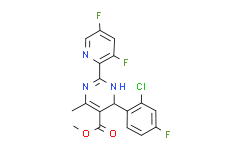| Cas No.: | 298708-79-9 |
| Chemical Name: | BAY41-4109 racemic |
| Synonyms: | Bay 41-4109 (racemate);Bay41-4109 racemate;Bay-41-4109 racemate;Bay 41-4109 racemate |
| SMILES: | O=C(C1=C(C)N=C(C2=NC=C(F)C=C2F)NC1C3=CC=C(F)C=C3Cl)OC |
| Formula: | C18H13ClF3N3O2 |
| M.Wt: | 395.766 |
| Sotrage: | 2 years -20°C Powder, 2 weeks 4°C in DMSO, 6 months -80°C in DMSO |
| Description: | BAY 41-4109 racemate is the racemate of BAY 41-4109. BAY 41-4109 is a potent inhibitor of human hepatitis B virus (HBV) with an IC50 of 53 nM. |
| In Vivo: | BAY 41-4109 reduces viral DNA in the liver and in the plasma dose-dependently with efficacy comparable to 3TC. BAY 41 -4109 reduces hepatitis B virus core antigen (HBcAg) in livers of HBV-transgenic mice. Pharmacokinetic studies in mice have shown rapid absorption, a bioavailability of 30% and dose-proportional plasma concentrations, about 60% in rats and dogs[1].BAY41-4109 inhibits virus production in vivo by a mechanism that targets the viral capsid[2]. |
| In Vitro: | BAY 41-4109 is able to both accelerate and misdirect capsid assembly in vitro. Preformed capsids are stabilized by BAY 41-4109, up to a ratio of one inhibitor molecule per two dimers[2]. BAY 41-4109 is equally effective at inhibiting HBV DNA release and the cytoplasmic HBcAg level, with IC50s of 32.6 and 132 nM in HepG2.2.15 cells, respectively. HBV DNA and HBcAg are inhibited in a dose-dependent manner, indicating that the anti-HBV mechanisms are associated with and dependent on the rate of HBcAg inhibition[3]. |






















